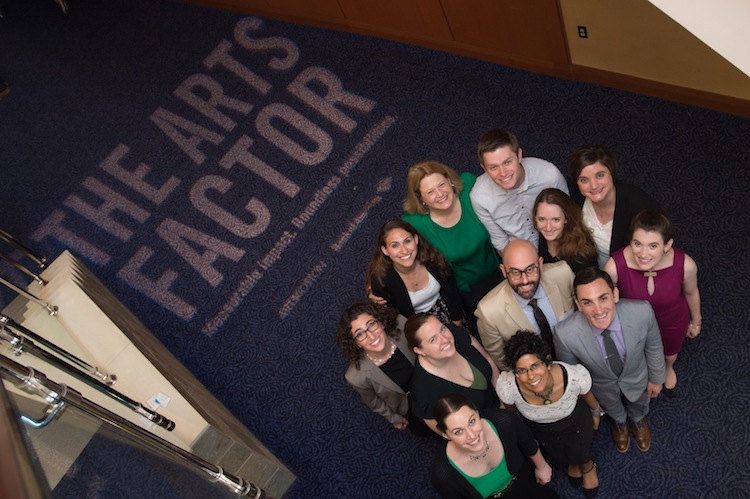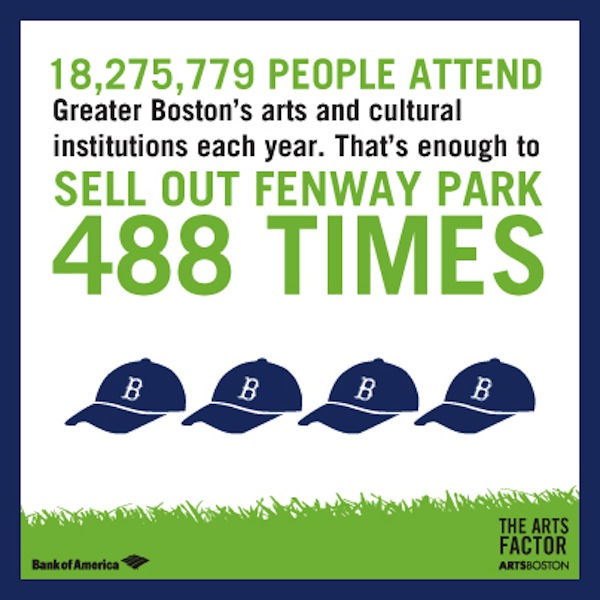Fuse Interview: ArtsBoston Launches The Arts Factor — A Fact-Based Shot of Courage
Until now, the powerful economic reality spotlighted by The Arts Factor has generally been ignored or dismissed as anecdotal.
By Bill Marx
Dramatist/poet Bertolt Brecht wrote that he wanted theater to generate the same kind of excitement and debate aroused by such spectator sports as baseball. He didn’t say anything about attendance, but, as you can see from the graphic above, trumpeting one of the eye-opening findings from ArtsBoston’s recent The Arts Factor report (sponsored by Bank of America), the regional nonprofit arts and culture scene draws crowds that dwarf those that attend sports events. (Total attendance to arts and cultural events come to more than 18 million people annually, more than four times the total attendance for Boston’s four major professional sports teams combined.) The truth is, arts and culture also gives history (tourism) a run for its money in terms of interest and dollars. This report offers hard numbers for these factoids, so, for once, bottom line muscle is backed up with stats.
Until now, the powerful economic reality disclosed by The Arts Factor (arts and culture pump $1.4 billion into the local economy through both direct spending by cultural organizations and incremental spending by audiences beyond the cost of admission) has been ignored or dismissed as anecdotal. The evidence is in, so an old question must be asked anew: why don’t arts and culture offerings garner the respect they deserve from the civic and political powers-that-be as well as the mainstream media? Big cities and their surrounding regions that offer a lot of arts/culture/entertainment customarily toot their own horn through advertising and branding campaigns. But, for whatever reason, Boston and environs tend to be more humble. Serious arts coverage is minimized. Why this is so is puzzling. The Arts Factor is invaluable because it will no doubt help change some local hearts and minds regarding the political support and editorial attention that arts and culture should command.
My customary caveat remains — the arts must not only be seen as a financial juggernaut, but treasured as an indispensable source of cultural, educational, intellectual, and political self-consciousness, a spiritual good that transcends commerce. In America, that is a hard argument to make, but those who believe in truth, beauty, innovation, and whatever else that lies beyond the inevitability of escapism and box office must never give up the fight. But praise be to ArtsBoston for proving the existence of the mountains (and mountains) of dollars and cents brought in by our nonprofit arts and culture institutions, as well as delving into the role they play in strengthening the quality of life in communities.
What action should the report spur? Maybe it could be used as a means to leverage local cities and the state to learn how to better brand and promote Boston internationally as an arts destination. The consensus is that the city already does huge tourism business — but why simply promote this one sector? Furthermore, an international advertising campaign (think the “I love New York” campaign of the 70s/80s) that promotes Greater Boston as an arts destination might not only highlight our high quality offerings around the country, but reduce our weird insecurity about our well-earned seat at America’s cultural table. Other cities promote their arts sectors. Places such as Chicago and Washington, DC and Seattle are always touting their arts festivals as a reason to visit. Boston needs to get over its reluctance; among its other merits, The Arts Factor offers a fact-based shot of courage.
I sent a few questions, via e-mail, to Jennifer Falk, Director of Marketing & Communications at ArtsBoston, about The Arts Factor, ranging from issues regarding aging audiences to wondering about the current data on the variety of audiences being served by the arts.
Arts Fuse: The argument for the economic power of the arts has been made in this state many times before. Why do you think this current report might be a game changer?
Jennifer Falk: It’s a game changer because while we’ve always known anecdotally that Greater Boston’s arts are important for quality of life, economic development, workforce retention, education, and community development we haven’t had the local data to back it up – until now.
The Arts Factor 2014 Report, a new research initiative by ArtsBoston and sponsored by Bank of America, uses never-before-published data from 354 nonprofit arts and cultural organizations that participate in the Massachusetts Cultural Data Project. It details the Greater Boston region’s cultural advantage in four main categories (Identity, Vitality, Innovation, Transformation), along with case studies that illuminate the cross-sector impact behind the data.
We specifically looked at data from the Greater Boston region – from Worcester to the North Shore through Boston to the South Shore – with the goal of creating a baseline report that helps quantify the sector and create a common narrative we can all use to advocate for deeper engagement and investment in the arts.
Arts Fuse: Is there any data on whether audiences for the performing arts are aging?
Falk: For the purpose of The Arts Factor 2014 Report, we did not look at specific audience demographics within the 354 nonprofits studied.
However, in 2012, we launched the ArtsBoston Audience Initiative (AAI) which is the region’s first resource for actionable data about the audiences of arts, culture and entertainment. We have almost 60 organizations of varying genres and budget sizes participating – including American Repertory Theater, the BSO, Isabella Stewart Gardner Museum and Company One – by pooling their audience data in one place. Currently it adds up to over 1.5 million unique households in Greater Boston (1 in 3 Boston metro households) and the data will become richer over time as more organizations come on board.
Over the past 18 months, we’ve focused our efforts in engaging more organizations to participate and use the AAI to improve marketing and development outreach. We’ve run sector-wide reports that include age, income and cross-over participation for use by participating arts organizations. We’ll be using this robust data set for future iterations of The Arts Factor.
Art Fuse: Can the data be broken out by neighborhood to see which neighborhoods have the greatest density of arts organizations and benefit the most from consumer spending?
Falk: The Arts Factor 2014 Report draws sector-wide conclusions to create a baseline narrative to empower and encourage local arts organizations, businesses and governments to be able to best leverage Greater Boston region’s cultural advantage. It does not look at individual neighborhoods or communities.
Arts Fuse: Do arts organizations have any data about what free events might convert attendees to come to future paid events?
Falk: This is exactly the question we want people to be asking based on this report. Thank you! As part of the ArtsBoston Audience Initiative, we encourage arts organizations to collect audience data on their free events so that they can measure results over time.
It’s an interesting question and one we’ll add to the growing list of specific areas to follow up on in future iterations of The Arts Factor research.

ArtsBoston Staff: John Beck, Jennifer Falk, Megan Graney, Stephanie Grubb, Ryan Impagliazzo, Daniel Jones, Bailey Lüthi, Vawnya Nichols, Ramona Ostrowski, Ruvani Perumal, Catherine Peterson, Lindsey Yanow.
Arts Fuse: Is there any data on which individual or household income brackets attend arts events to get a better sense of who is being served? And who is not being served?
Falk: Over the past 18 months, we’ve focused our efforts in engaging more organizations to participate in the ArtsBoston Audience Initiative and use the AAI to improve marketing and development outreach. We’ve run sector-wide reports that include age, income and cross-over participation for use by participating arts organizations and look forward to digging deeper into this data set for future iterations of The Arts Factor.
Arts Fuse: Is there data from other companies about choosing Boston over another city because the lifestyle it offers (including the arts) makes it an easier people to hire and recruit people to?
Falk: We did a significant literature review to inform our thinking for The Arts Factor. Key research that informed our work included Endeavor Insights’ “What Do the Best Entrepreneurs Want In A City?” which is based on surveys of CEOs of the fastest-growing companies in the US, to find out why they started their company where they did. The answer was simple: access to customers, access to a talented workforce, and most importantly access to a place where they wanted to live. These CEOs cited quality of life (including arts and culture) as more important than tax rates or business-friendly policies in determining where they chose to start companies.
In Boston, David Friend, CEO of Carbonite agreed the arts are not just nice, they are necessary, saying “The arts are a major factor in my choice to start a business in Boston. For companies interested in attracting smart and creative knowledge workers, being located within a vibrant arts community is key.”
There are other stories out there that we look forward to collecting. The purpose of the report is to open the door for exactly these types of conversations.
Bill Marx is the Editor-in-Chief of The Arts Fuse. For over three decades, he has written about arts and culture for print, broadcast, and online. He has regularly reviewed theater for National Public Radio Station WBUR and The Boston Globe. He created and edited WBUR Online Arts, a cultural webzine that in 2004 won an Online Journalism Award for Specialty Journalism. In 2007 he created The Arts Fuse, an online magazine dedicated to covering arts and culture in Boston and throughout New England.
Tagged: ArtsBoston, Boston arts, Jennifer Falk, branding, nonprofit arts and culture institutions


